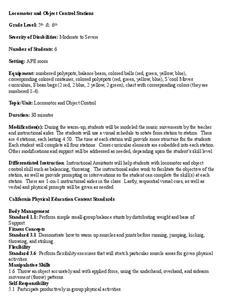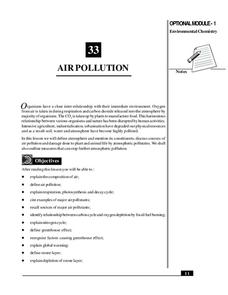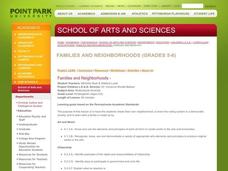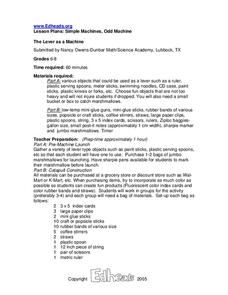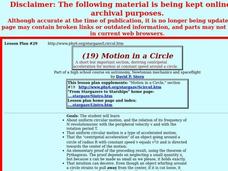Scholastic
Spring Is Sprung: Water Movement in Plants
Young scientists use food coloring and celery stalks to determine how water travels through plants.
1 plus 1 plus 1 equals 1
I Can Read! Sight Words Set #2
Practice reading common sight words with a series of enriching activities. From bingo to connecting the dots to matching words, the packet has something for everyone!
Teach Engineering
Cost Comparisons
Our final proposal for the cost of the bridge requested is ... In the last segment in a series of 10, pairs work together to develop a proposal for a city bridge design. The class completes a cost comparison between concrete and steel to...
Teach Engineering
Tissue Mechanics
Engage your class by showing them how silly putty and human tissues are alike. Pupils learn more about tissue mechanics by reflecting upon their experiences with silly putty. The instructional activity covers collagen,...
Teaching Adapted PE
Locomotor and Object Control Stations
Develop children's basic locomotor and object control skills with an invigorating Adaptive PE lesson. A series of four, timed stations engaged the class in playing a game of Twister, walking on a balance beam,...
Deliberating in a Democracy
Preventive War
"Those who knocked these buildings down will hear from all of us soon!" - George W. Bush. Scholars investigate and analyze the events of September 11, 2001 in ushering in the Bush Doctrine on foreign policy. Using primary documents as...
California Polytechnic State University
Australian Geography Unit
At the heart of this resource is a beautifully detailed PowerPoint presentation (provided in PDF form) on the overall physical geography of Australia, basic facts about the country, Aboriginal history, and Australia culture and lifestyle.
Illustrative Mathematics
How Many Cells Are in the Human Body?
Investigating the large numbers of science is the task in a simple but deep activity. Given a one-sentence problem set-up and some basic assumptions, the class sets off on an open-ended investigation that really gives some...
National Institute of Open Schooling
Air Pollution
Seventy percent of the air pollution in China is due to car exhaust. Under the umbrella of environmental chemistry, learners extensively explore air pollution. From the makeup of our atmosphere to sources of major air pollutants, classes...
Curated OER
Bridge Design and Bridge Building
Seventh graders conduct an investigation into the design of bridges and their construction. Students design bridges and draw detailed plans. For assessment they construct a model of a bridge that is made entirely of toothpicks. Students...
Curated OER
Families and Neighborhoods
Students build their own neighborhood. In this lesson on community, students are introduced to books about families and neighborhoods. As a class, the students create their own neighborhood, elect a leader for their neighborhood and...
Curated OER
Magnetic Induction
In this electricity instructional activity, students learn about magnetic induction plus compare a generator with a motor. Students also review the different kinds of energy and the formulas associated with energy. This instructional...
Curated OER
Simple Harmonic Motion
Young scholars study harmonic motion and its oscillation. In this simple harmonic motion instructional activity students demonstrate a series of regular oscillations and explain the theory behind the experiment.
Curated OER
Simple Machines, Odd Machines
Students recognize and identify common objects that can be used as a lever. In this simple machines lesson, students experiment with materials to design and construct a machine that uses a lever. Students also design and build a catapult.
Curated OER
MOTION IN A CIRCLE
Students explore uniform circular motion, and the relation of its frequency of N revolutions/sec with the peripheral velocity v and with the rotation period T, and the "centripetal acceleration" of an object.
Alabama Learning Exchange
Energy and Work Amusement Park Style
Students distinguish between kinetic and potential energy. They recognize that energy can change from one form to other forms. They identify and describe several forms of energy.
Curated OER
Particle Models
In this particle model worksheet, students solve and complete 14 various types of problems. First, they find the magnitude of the side or the angle indicated with a question mark for each triangle illustrated. Then, students find the x...
Curated OER
Movie Genres
For this grammar worksheet, students match twelve movie genres with their appropriate definitions and examples from two answer banks and then translate the titles into Chinese. Students answer six questions regarding personal movie...
Curated OER
Jeopardy 8th Grade (Science)
There are so many topics touched upon in this Jeopardy-style science game, that it is difficult to classify! The categories include electricity, matter, ecology, earth and space, and scientific investigation. This would best be used at...
Curated OER
The Labor Force and Unemployment
Students calculate employment and unemployment rate. In this economics lesson, students investigate the labor market and make predictions based on collected data. They also calculate unemployment rate in the class.
Curated OER
Forces Cause Change
Third graders will gain recognition that physical relationships affect each other and that change occurs when one object acts upon another.The teacher will recognize ways in which technology can be used to enhance the understanding of...
Curated OER
The Driving Force
Students work in groups and note similarities and differences between their boats: size, shape, color, and unique features. They discuss 3 typical means of propulsion: propellers, sails, and paddles then share their charts with the class.
Curated OER
TE Activity: Testing Fundamental Loads
Students experiment with the five fundamental load types that can act on structures. They use foam insulation blocks to which they apply the forces and draw the fracture patterns. They determine the telltale marks of failure that is...
Curated OER
Magnets 2: How Strong is Your Magnet?
Pupils work together to test the strengths of various types of magnets. After testing, they create a graph showing how the strength changes as the distance from the magnet increases. They discuss how forces can act from various...




